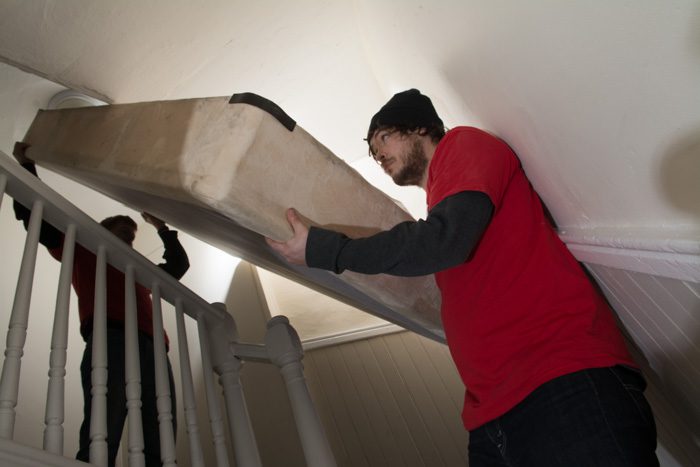Moving Beds the Safe Responsible Way!
As you’d expect, moving beds is one of the most common tasks that a moving company encounters. Most people have at least one.
The typical bed has three components — a mattress, a box spring, and a structure like a frame or platform. When we use the word “bed,” it is this structure that we’re talking about. For tips on protecting mattresses or navigating box springs through tricky stairwells, check out our moving tips.
Also, if asked, we’ll hoist your box spring over a porch or through a window at no additional charge. We also carry protective plastic stretch-wrap that we can use to protect your mattress if necessary. For additional protection, you might want to purchase mattress bags ahead of time to protect both your mattress and box spring.
Mattresses are often pliable enough to make their way up or down a narrow staircase. And box springs are light, flat, and narrow enough to fit through tight turns, or, if need be, over porches and out windows. But, almost always, frames are a different story.

Most of us spend a good chunk of our lives in our beds. So it’s important to use care when transporting them. By Nationaal Archief, Den Haag, [CC BY-SA 3.0 nl], via Wikimedia Commons
When Moving Beds, the frame always needs to come apart!
From small, simple metal frames to much more complicated constructions, beds almost always need to come apart to get out of a home or into the truck. Furniture makers design bed frames to be stationary. Even if a frame might theoretically fit though the negative space afforded by a stairwell or hallway, twisting and turning that frame to get around corners could shift its weight in ways it wasn’t designed to bear.
Luckily, most carpenters and furniture manufacturers know this. So they make beds to be taken apart and put back together with relative ease.

18th-Century Polish-Style Bed from Warsaw’s Royal Castle. (Source: Wikimedia Commons)
Metal bed frames are usually the easiest, quickly snapping together or coming apart in a matter of minutes. Some wooden beds (and notoriously, Ikea particle board beds), are held together by dozens of screws, nuts, and bolts.
Of course, it may seem tempting to grab a power drill when looking at all that tightly fastened hardware. But it’s important to remember that bed screws are generally not the sturdiest pieces of metal. Specifically, manufacturers design them to restrict the movement of the various pieces of wood, not to support weight, so they are rarely heavy-duty in any way. Similarly, if your bed is made of particle board, the heavy torque of a power drill can strip the screws. If that happens, putting them back in (or worse, taking them out) can become almost impossible. Beyond that, the drill can also split and crack the wood and ruin your bed.
The Lesson: Drills and Beds make Strange Bedfellows
Annoying as it may be, there’s a simple lesson about moving beds. The lesson is, of course, to always remove bed screws and other hardware with a hand screwdriver or wrench. However, it certainly can be a time-consuming process. So let’s you’re hiring movers, but you still want to save a little cash on moving day. In that case, it’s always best to dismantle and re-assemble your bed on your own. Especially if you have an Ikea bed, taking the initiative to do it yourself can save your movers a half-hour of labor time or more.
Of course, any reputable moving company (like Safe Responsible!) will happily take apart and put back together your bed, no matter how simple or complicated it is.
Pro Tip: Split Box Friends are your Friends!
Moving beds is much easier when the box spring comes in two pieces. We recommend to anyone living in Boston to invest in one. No matter how you do the math, the split box spring always wings. Simply put, a split box spring is a box spring that comes in two pieces. So you’re moving two twin box springs instead of one big one. As you might expect, moving two small pieces is much easier, and of course cheaper. You can read our guide to getting a split box spring here.
If you’d like to learn more about moving beds or see the experts in action, submit a request for a quote today and we’ll get back to you as soon as we can!

